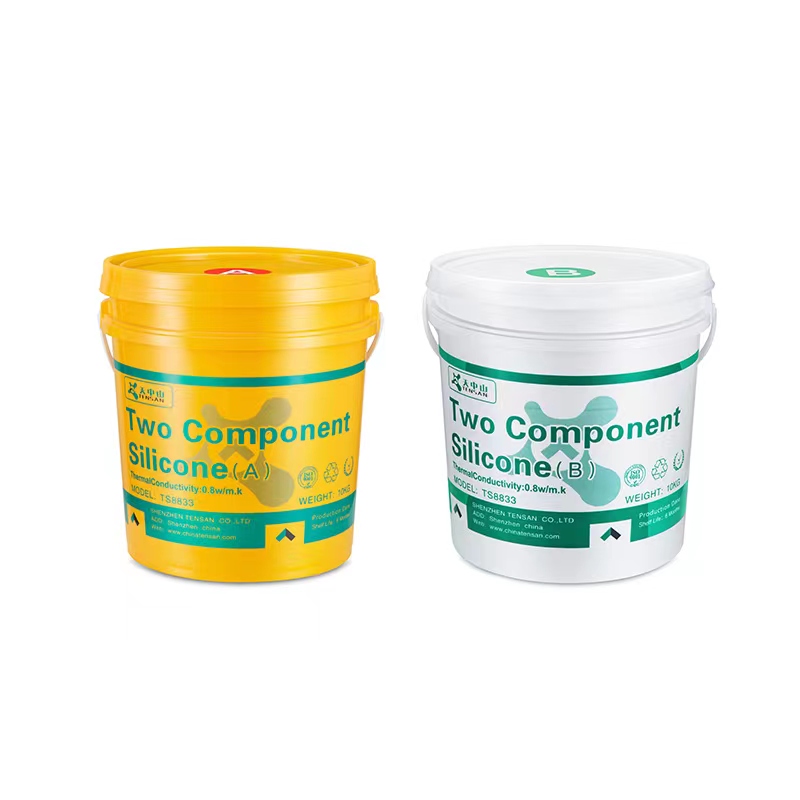What is the difference between thermal conductive encapsulant and silicone elastomer?
Thermal conductive encapsulant and silicone elastomers are related but distinct materials in nature, mainly reflected in their specific functions and uses.

Thermal conductive encapsulant is a two-component condensation thermal potting adhesive, which can reliably protect sensitive circuits and components in a wide range of temperature and humidity changes for a long time. It has excellent electrical insulation properties, can resist environmental pollution, and avoid damage caused by environmental factors such as stress, vibration and humidity. It is especially suitable for products requiring good heat dissipation of potting materials. The product has excellent physical and chemical resistance. It can be cured at room temperature or heated quickly after 1:1 mixing, with minimal shrinkage, no heat release in the curing process, no solvent or curing by-products, with repairability, and can be deeply cured into elastomers.
Silicone elastomers are made with a combination of linear polymers, reinforcing agents, a crosslinker and a catalyst. The viscosity and type of the basic straight-chain molecule combined with the processing temperature determine the type of elastomer produced: Heat Cured Rubber (HCR), Liquid Silicone Rubber (LSR), and Room Temperature Vulcanization (RTV). These elastomers can be reinforced with either mineral fillers, such as silica, alumina, calcium carbonate, silicone resins, etc. Radical, condensation or addition crosslinking reactions may be used depending on the technology chosen to meet precise processing requirements. A wide variety of additives can be added to the elastomer in its final composition to ensure specific characteristics (color, rheology, pot life, etc.) or performance standards (electrical insulation or conduction, heat transfer, fire retardancy, chemical adhesion, mold release, etc).
Thermal conductive encapsulant
Thermal conductive encapsulant is a thermal management material specifically designed for use in electronic devices. It has the following features:
1. Thermal conductivity: The main function of thermal conductive encapsulant is to conduct heat, which can effectively conduct the heat generated by electronic components and prevent the equipment from overheating.
2. Potting and protection: It can not only conduct heat, but also potting electronic components to form a protective layer to prevent dust, moisture, chemicals and other external factors on the erosion of electronic components.
3. Curing characteristics: Thermal potting adhesive usually exists in the form of two components, which can be cured at room temperature or heating conditions after mixing to form an elastomer or hard body.
4. Application range: Widely used in power modules, high-frequency transformers, connectors, sensors and electric heating parts and circuit boards between insulation and thermal sealing.
Silicone elastomer
Silicone elastomer is a polymer material with excellent elasticity and weather resistance, its main characteristics include:
1.Elasticity: silicone elastomers have good elasticity and can withstand deformation and restore to the original state within a certain range.
2.Weather resistance: It can maintain stable physical and chemical properties in a wide temperature range, and resist the erosion of ozone, ultraviolet and other environmental factors.
3. Insulation: silicone elastomers also have good electrical insulation properties, suitable for occasions where electrical insulation is required.
4. Application range: silicone elastomers have a wide range of applications, not only limited to electronic equipment, but also including sealing, shock absorption, protection and other aspects.
Differential induction
1. Functional focus: thermal conductive encapsulant are more focused on thermal conductivity and potting protection, while silicone elastomers are more focused on their elasticity and weather resistance.
2. Applications: Although both have applications in electronic devices, thermal conductive encapsulant are more commonly used in applications that require thermal management, while silicone elastomers may be more widely used in applications that require elasticity, weather resistance or electrical insulation.
3. Material form:thermal conductive encapsulant usually exists in the form of two components, which need to be cured after mixing; Tridacnone elastomers may exist in a variety of forms, including liquid or solid, and their curing mode may vary depending on the specific application.
In summary,thermal conductive encapsulant and tridacnidone elastomer have their respective features and uses and should be considered according to specific needs.








